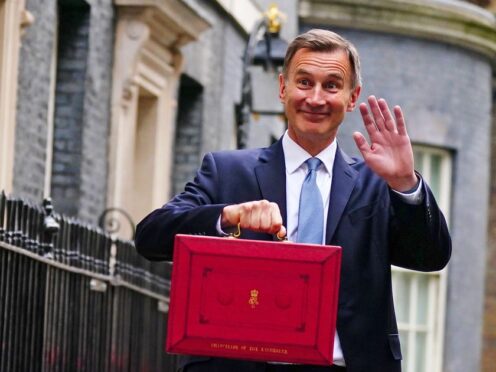
The Chancellor should resist announcing tax cuts at next week’s Budget unless he can show how he will pay for them, the Institute for Fiscal Studies (IFS) has said.
Jeremy Hunt faces continued pressure from Conservatives to cut taxes when he delivers what is likely to be his final Budget before the next election, as the overall tax burden approaches record levels.
The IFS warned on Tuesday that current post-election spending plans already meant further cuts to unprotected public services – such as local government and the court system – which reducing taxes would only exacerbate.
The well-respected think tank said failing to set out exactly what spending cuts would be used to “pay for” tax cuts would “lack credibility and transparency”.
Official forecasts of the Chancellor’s “headroom” against his plans to get borrowing to fall in five years’ time are understood to have moved against the Government and Treasury sources have said Mr Hunt is considering a further squeeze on public spending plans as a way to deliver tax cuts.
Martin Miklos, research economist at the IFS, said: “In November’s autumn statement, the Chancellor ignored the impacts of higher inflation on public service budgets and instead used additional tax revenues to fund eye-catching tax cuts.
“At next week’s Budget, he might be tempted to try a similar trick, this time banking the higher revenues that come from a larger population while ignoring the additional pressures that a larger population will place on the NHS, local government and other services.
“He might even be tempted to cut back provisional spending plans for the next Parliament further to create additional space for tax cuts.
“The Chancellor should resist this temptation. Until the Government is willing to provide more detail on its spending plans in a spending review, it should refrain from providing detail on tax cuts.”
In analysis published ahead of next week’s Budget, the IFS suggested the budget deficit may be around £11 billion smaller than it was forecast to be in November, but still much higher than it was forecast to be in March 2022.

The IFS also said the faster population growth projected by the ONS could boost revenues, but also meant current plans would see per-person spending rise by just 0.2% per year after the election.
Factoring in likely spending plans for the NHS, defence, schools and childcare meant other departments would see around £20 billion per year in real-terms cuts by 2028-29, with another £20 billion per year set to be taken out of investment spending.
Both the IFS and Office for Budget Responsibility have previously expressed scepticism that the spending cuts pencilled in for after the election will be delivered, with IFS director Paul Johnson telling reporters the Chancellor was “to some extent … gaming his own fiscal rules”.
The IFS added that if the Chancellor was determined to cut taxes, it would be better for growth to cut stamp duty on purchases of property and shares rather than cutting income tax or national insurance.
But the Chancellor faces demands in the other direction from sections of his party, demonstrated by proposals put forward by the Liz Truss-backed Growth Commission on Tuesday.

The commission, set up by the former prime minister to push policies for economic growth, recommended a wide range of tax cuts including abolishing inheritance tax, cutting corporation tax and unfreezing personal income tax allowances.
The group claimed this would boost GDP per capita by 5.7% over the next 20 years, and also recommended radical reform to planning laws, eliminating restrictions on overtime work, making it easier for companies to sack workers, freezing the minimum wage and imposing even stricter requirements for receiving welfare payments.
Launching the proposals, Growth Commission director Lucy Harris said: “The approaches that have brought us to stagnation cannot bring us out of it.
“This is why the work of the Growth Commission is so important. Only by taking a cold, hard look at the economic fundamentals and by adopting our model of the economy which actually confirms the observed human and market behaviour can we come up with the policy responses that actually achieve the fundamental goal of bringing the UK back to growth.”
According to The Times, Mr Hunt is considering further slashing national insurance at the Budget, having cut it by 2p at the autumn statement, and could announce a duty on vaping.
The PA news agency understands a vaping levy is an option for the Chancellor but Mr Hunt’s aides said they would not comment on speculation around potential tax cuts.
A spokesman for the Treasury, responding to the IFS report, said: “Our responsible action with the public finances meant we could cut taxes for working people and businesses in the autumn statement.
“We will not comment on speculation over whether further reductions in tax will be affordable in the Budget.
“We are on track to meet our fiscal rules and total departmental spending will be £85 billion higher after inflation by 2028-29 than at the start of this Parliament, including record funding for the NHS.”

Enjoy the convenience of having The Sunday Post delivered as a digital ePaper straight to your smartphone, tablet or computer.
Subscribe for only £5.49 a month and enjoy all the benefits of the printed paper as a digital replica.
Subscribe